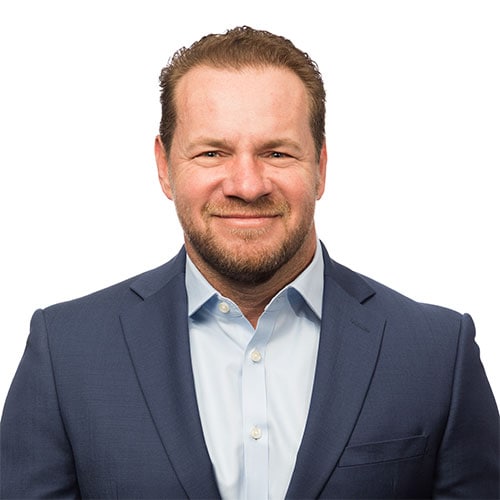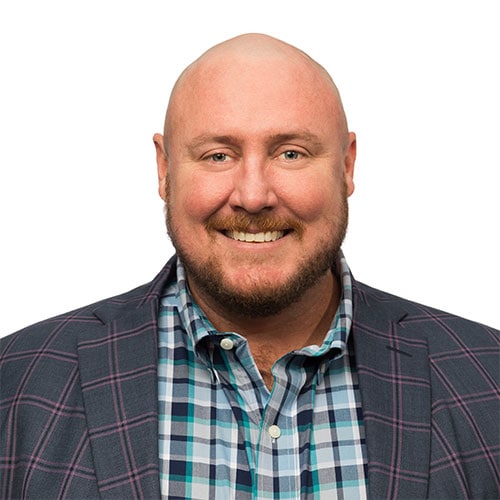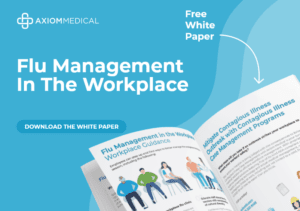[00:00] – Holly Foxworth
Welcome. Hey, I heard something in the background there. Good afternoon. Welcome. Thanks for joining us today for the Liability, Responsibility, and Maintaining Profitability Workplace Safety Expectations Unchanged by the OSHA ETS webinar that we are putting on today. I know it’s been a busy week and looks like we had a lot of news that occurred this last week as well, especially on Thursday when we had the Supreme Court and the decisions that were made there. So we have a lot of good information to talk about. We’re talking through all of those individual pieces and then also how it is that you’re going to be able to navigate through some of these upcoming changes that are occurring and then also best practice. So in case, we haven’t met yet, my name is Holly Foxworth. I am a registered nurse. I’m also the marketing manager for content here at Axiom. And I have joining today Dr. Scott Cherry. He’s our Chief Medical Officer. And I think we should have Chuck Kable, who’s our Chief Legal and HR officer. If he hasn’t made it on yet, hopefully, he should be here shortly. Chuck, are you with us?
[01:02] – Chuck Kable
I am, Holly. Sorry. I’m right here.
[01:04] – Holly Foxworth
Good. Hey, no worries. All right. Good deal. Before I had to introduce themselves, let me just kind of talk you through several things. I want to bring your attention before we get started. So the first one is at the top right-hand side of your screen. You’ll notice that we have a box there where it is that you can register for the next event. So this is actually going to be an event that talks through an Insider’s view of what’s going on with employee health and government regulations. So we are going to have Dr. David Michaels. He’s going to be back. As you guys may remember, he had done several webinars with us before. He had been represented for OSHA, and he’s also working in higher levels of government, their wealth of knowledge. So he’s going to be joining along with Dr. Scott Cherry as well. So we’ll go through that. What we would like you to do, though, is if you’ll just press that Register Now button, that’s going to be this next week. It’s on Thursday when we normally do this. This is going to be on a Wednesday. So next Wednesday at 1 pm CT. And if you’ll just click that Register Now button that will get you registered, you don’t have to put in any additional information. You’re also welcome to share it with your colleagues and contact it out and just kind of get around the same page. And so we know what to expect as the year progressed. So there could be some big moves on the horizon there. The next thing I mentioned was there in the resource section I saw we already had some questions that came up about would we have resources available? And absolutely, we do have those resources that are there so in that bottom section on the right side, you’ll see that there should be a file that would have the slide deck from today. It also has the risk calculator, along with some industry-specific best practices for how it is that you can set up some new policies through there. So I think that’s the majority of what I wanted to go over. We kind of noticed that you guys seem to like more of the open format where we’re going through some of the questions that you submit while we’re on that topic. So as many of those as we can get to while we’re having Dr. Cherry and Chuck speak would be great. If we can’t get them in that section, we’ll pick them up on the back end. But outside that, I think that should do it. Do you want to introduce yourself first, and then we’ll go on over to Chuck.
[03:18] – Dr. Scott Cherry
Yes. Thanks, Holly. My name is Scott Cherry. I’m actually Axiom’s Medical Chief Medical Officer. My professional background is I’m board-certified in preventative medicine, public health, and occupational environmental medicine. I’ve been supporting either the military, government, and corporate and industrial operations for the past 15 years. And it’s a pleasure to be with you.
[03:39] – Holly Foxworth
Awesome. Thank you. Thanks for joining. How about you Chuck?
[03:43] – Chuck Kable
Sure. First of all, just apologies. I’m having some technical challenges with my setup here, and so my camera is not functioning. Apologies for that. But Chuck Kable, I’ve been a lawyer for over 20 years, have spent essentially, well, almost all of my career in some aspect of healthcare. So I’ve worked on the payer side, hospital operations side, revenue cycle site, and occupational health side. Now for Axiom, I think that I kind of bring an interesting perspective and that I’m able to kind of bring together all the different privacy challenges and issues that come up in this stuff. And obviously, I’ve been spending a lot of my time observing and watching what’s happening with OSHA, the Supreme Court. I’m happy to be here today. And I also happen to run human resources for my HR people out there. I can hopefully help you provide you with some clarity around how to think about everything. But I’m happy to be here today.
[04:38] – Holly Foxworth
Absolutely. Thanks for joining us, Chuck. Well, just to kind of give you an idea of what it is and how it is that we’re going to progress through some of these things here. So we have in terms of the topics, we’re going to first try to get a check-in from Dr. Cherry and go through where we’re at, where we sit with cases, and what some of those projections look like as that has changed since this last week. We will also talk through then the OSHA ETS status from Chuck, talk about some of these kinds of different ways that you can affirm your commitment to safety, what it is and how you respond to employees that once said, hey, this is going to be a regulation, and we need to follow this route. And then all of a sudden some of that news changes a little bit. So we’re going to give you some tips on that and then finish up with the industry best practices on how it is that you can kind of customize what you have going on there. So I’ll kind of turn things over to you then, Dr. Cherry first if you would give us an update on where we stand and what things look like, and what we need to be looking for next.
[05:36] – Dr. Scott Cherry
Yes. So this slide is looking at the US, but it’s really kind of a phenomenon for many countries in the world. But what we’re seeing with this Omicron spike is really like a ten-fold increase in cases. So if you kind of look at the end of this chart to the right, you just see this huge spike kind of plateauing right now, about 800,000 cases per day. And so just in the span of three to four weeks, we were at 80,000 cases a day. So really a 10X increase, which is really dramatic. We’re seeing lots of breakthrough infections from fully vaccinated and from those with natural immunity from before. And so I think this is really challenging the way experts view how COVID-19 may end or if it may just become what we call endemic. And so the previous coronaviruses in the last 20 year outbreaks, the SARS and Mers, fortunately, those were able to kind of be eliminated or at least limited to just a few countries and never had broad spread. What we’ve seen with COVID now it’s been going on two years, and I think there was hope that the vaccines would actually kind of be the tool that would actually kind of bring this to an end.
[07:21] – Dr. Scott Cherry
But now with such huge infections, I think we’re starting to see our public health authorities start discussing, is this more endemic than a pandemic that could be kind of ended with some type of whether it’s a single tool or multi-layered approach. So, yeah, I think this is pretty compelling data here that’s really hard to understand. Omicron is just so much more infectious than Delta, and Delta was very infectious. And so we’re just seeing these huge outbreaks.
[08:05] – Holly Foxworth
Yeah. So several questions on that we’ve heard a lot of feedback on and would love your view on this Doctor Cherry. The first being it looks like everybody’s progressing at a different rate. So can you explain why it is that maybe places like New York that first saw a huge surge in cases and now feel like they’re starting to kind of come down off of that peak? Why it is that there’s a time-lapse between what could be occurring in the Northern States versus us here in the south?
[08:39] – Dr. Scott Cherry
Yes, I think there is seasonality that was going to be expected as a reason for a surge separate from a new variant like Omicron that is quite infectious. And I think we were seeing a lot of States, especially in the north, that was having early rises in cases. And then I think the other big driver is the density of population. And so with cold weather and highly dense populations where everyone is indoors and then in higher density living conditions, I think that’s what we’re seeing. What always is kind of interesting to me is there’s this cycle, though, to where there’s some type of equilibrium that happens. And obviously, this one is happening at a much higher level. I don’t know if we would call it herd immunity, but it’s some type of equilibrium that does cycle in and out and brings infections back down. And so before we had interventions like social distancing, lockdown, vaccines. Now we have therapeutics, too, that help with severe disease prevention in addition to vaccination, but that doesn’t really affect case counts. And so this slide really just is talking about cases in general.
[10:06] – Holly Foxworth
Yeah, definitely. And then I saw that Robert had submitted a question here. I don’t understand why the US would, which would have the most advanced healthcare, has very poor performance. And he was saying January 2022 month to date, 98 deaths per million, and was asking is this a failed policy because of vaccine only strategy and a lack of early treatment?
[10:35] – Dr. Scott Cherry
I think that is a good question. It is difficult to compare one country to another, even if it was first world country or kind of similar health system kind of sophistication because some of the other things that may actually play a big part in the outcomes are kind of just the status of the health of the average person in that population. I think Africa especially has fared quite well with regards to severe disease. And even with Omicron, where Omicron started out, was first detected in South Africa. And so it’s really hard to compare. We do think in general in first-world countries with robust health care systems that we can really manage the outcomes as best as possible. But just some of my intuition is that some of the other countries that have better outcomes may just have healthier people, or it could be just a reporting bias where they’re not testing as much. It can be a host of things. So it’s really hard to have a direct comparison, but I would definitely for the US, I think it’s a mix of making sure people have access to therapeutics to prevent severe disease, make sure people have the tools to make themselves as healthy and resilient before they become infected and probably a host of other things. But I think it’s just hard to compare one country to another.
[12:21] – Holly Foxworth
Definitely. Yeah. And then one more question from Savannah was asking, has Omicron been less deadly and symptoms less severe than other strains of the virus, and will this continue to be a trend for future strains.
[12:35] – Dr. Scott Cherry
Yeah, I think we’ve seen some consistent studies from several countries that have shown, fortunately, Omicron is much less severe. What’s kind of complicating the facts, though, is that because we’re having a 10X rise from October, November, and even if you look at the other peaks, we’re at least 3X, the biggest peaks in the previous time frame. So just doing some simple math, if Omicron created one-third the amount of hospitalizations that Delta or Alpha did just based on numbers, you’re still going to get a very similar number of hospitalizations just based on much larger numbers being infected. But again, if Omicron was creating severe disease as much as Delta, it would have truly probably overwhelmed the hospital system. I think hospital systems are full. But again, Omicron is much less severe.
[13:44] – Holly Foxworth
Right? Yeah. Good information. All right, well, check. I wanted to kind of touch base with you then here as we get into the OSHA ETS and kind of talk through what some of those implications were from the Thursday update that we had and where we go from here.
[14:00] – Chuck Kable
Sure. A lot of questions from folks about this topic. Right. And there are a couple of ways to think about it. I’ll give kind of my personal perspective on it. But that being said, let’s jump into kind of where things stand today. Right. So what we know is the Supreme Court has essentially said that OSHA may not enforce its new ETS for employers with over 100 employees. Right? This is what everybody calls the vaccine mandate. They’ve said, OSHA, just pause. You can’t do anything. Now, what does that mean? Does that mean that essentially the cases are won and decided? No, it doesn’t. One of the procedural tools at a lawyer’s disposal is this thing called the request for an injunction or request for a stay, which is a kind of pretrial motion where you’re asking a judge to like, don’t make my client do something or make them do something while we decide this case on the merits. Traditionally, it’s stopped. Right? It’s where you typically find these injunctions in these stays being sought. And so in this case, that’s no different. The lawyers said we don’t feel like we should be taking steps to move towards compliance because too expensive outside of their authority to do this, etc.
[15:23] – Chuck Kable
And Supreme Court ultimately said, we agree with the Fifth Circuit. We don’t believe anybody should take steps to comply, OSHA, you cannot move forward. So the case isn’t over, though, right? So now what’s happening is back in the 6th Circuit. Remember, all these cases got consolidated to the 6th. The case will proceed on the merits. And so this is where the parties will bring evidence. They’ll run through discovery, and they’ll dig into the issues that the court commented on in the opinion. Right. So the Supreme Court believes that there is a high likelihood that the petitioners, the people kind of challenging the ETS will win. That doesn’t mean they will. But it certainly is material to thinking through the frame which this whole thing is going to be viewed by the court system. And so now it will take months to essentially get through that process. It will certainly take more than the six months that the ETS was originally expected to be in place. What does that mean today? Well, it means the businesses still need to take steps to make sure they can operate. So kind of first thing now that we don’t have to kind of, quote, unquote, worry about regulation and being forced to do things we don’t want to do now, it’s like, okay, what do we have to do to keep the doors open? What have we done that’s worked as we face kind of this huge increase in infections with Omicron, if we have a workforce that has to show up somewhere and interact with members of the public or other people are in tight spaces, what are we doing to protect them?
[16:59] – Dr. Scott Cherry
Because, again, the general duty clause from the OSHA ETS still applies. You still have a duty as an employer to take steps to reasonably protect your employees from unreasonable risk of injury or illness. So there’s still an element of policy, administration, and safety that has to be addressed here. But now employers have some freedom to now take that step back and identify what was working, what wasn’t working, and what they need to do differently to ensure that their workforce is able to continue to show up for work. Because that’s what we’re talking about here at the end of the day. It’s like, what are we doing to make sure our folks show up for work because the people don’t feel safe, they’re going to quit, they’re going to leave. They’re going to find a better position. They’re going to try to find a remote job where they don’t have to worry about all the stuff. Any number of things can happen. And again, as I’ve said many times before, what’s critically important right now is for employers to remember that whether they like it or not, their actions and their failure to act are being judged by their employees every day. And so it’s up to you as an employer to set the narrative. Tell your story, talk about why you feel like what you’re doing is sufficient. Talk about the way you view employee health and safety in your workspace and workplace and follow it up. Take steps to protect people and be reasonable and rational. You don’t have to go through kind of what may be perceived in some circles as unreasonable costs and those kinds of things. But make no mistake, OSHA still has a right to come into the workforce or workplace, rather, and address and look at the safety protocols in place. And you better believe that the frame through which OSHA will view these visits is through their perspective on what employers should be doing to protect their workforces. So I think I covered kind of one, two, and three all at the same time there on the screen. But that’s kind of the nuts and bolts of it. There’s no magic, you know, one thing that’s going to set you free here, it’s going to be a combination of factors that are tailored to your business and the risks that your folks are dealing with day in and day out.
[19:20] – Holly Foxworth
Yeah. Hey, Renee had a question was asking. I’ve heard about the OSHA mandate in health care. However, I haven’t heard anything about the federal contractor mandate. Do these court cases have an effect on that?
[19:35] – Chuck Kable
Yeah. The federal contractor mandate is being litigated, and I believe I want to say like 23 States. I think there’s been a state issue relative to that aspect of it. I can’t tell you how many litigated cases exist on the federal vaccine mandate, but they exist, although I have read that enforcement has begun in some respects. I think what was it? Maybe it was at the Department of Defense or the Department of justice. Somebody just laid off a ton of folks that were or perhaps they were on the verge of being terminated, is what I read. There’s no across-the-board ruling on the federal vaccine mandate. On the healthcare ETS, I’ve seen there’s a lawsuit to kind of make it more expensive because OSHA kind of slimmed it down once the six-month timeframe ran as they seek to come up with a more permanent standard, which is happening, by the way, for my friends in healthcare, there will be a permanent standard at some point down the road. So there’s litigation there. But I haven’t seen anything that rises to the level of what we saw with the so-called vaccine mandate for normal businesses.
[20:52] – Holly Foxworth
Yeah. Good information. Hey, Dr. Cherry, it looks like Robert asked a question we might come back to. I guess you both probably actually add into this, but Robert was asking right now, the vaccines do not stop transmission of infection. In fact, many people who are vaccinated at my company are getting COVID and they’re symptomatic more so than the unvaccinated personnel. Again, the vaccine-only strategy is failing, and we have continued our strategy of social distancing, health monitoring, and facial covering, although the science doesn’t support that. Is there anything that you wanted to maybe kind of speak to about the effectiveness of vaccines and why this could be a little bit different?
[21:31] – Dr. Scott Cherry
What was the last part, Holly, that you said?
[21:33] – Holly Foxworth
Yeah, he was just saying that. Again, it doesn’t look like this vaccine strategy is working and that they have also utilized in the social distancing, the health monitoring, face coverings, etc, but still having some positive cases, it sounds like.
[21:48] – Dr. Scott Cherry
Yes. I think vaccine breakthrough infections have always been a really tough discussion point at the theoretical level. When the vaccines were first released, really the primary outcome was severe disease prevention. So even back then, we do not recommend treating vaccinated and unvaccinated employees differently. I think with the Biden mandate a year or longer later, it kind of reinforced that misinformation or that misconception that, hey, the vaccines are very effective, so it’s actually preventing infection. And there is data that shows that it does help, at least before Omicron, it helps, but it’s not like a sterilizing vaccine that prevents infection. And so I think now, especially with Omicron, it’s very clear because there are so many breakthrough infections in the vaccinated. But I do agree with his comments. And this has been kind of a tough point in society because so many people were hoping that the vaccine would be the end of the pandemic. But like we’ve always said, you really want to have kind of this multi-layered approach. And I also appreciate the point about the science behind social distancing and face masks. There have been a couple of studies in the last several months that have come out that were really beyond case reports.
[23:35] – Dr. Scott Cherry
Before that, the CDC was really relying on case reports, which isn’t a very strong level of evidence for face mask use. But now we’re seeing that surgical masks, cough masks really are not effective. So using a surgical mask at a minimum and then really N95 is really the protective effort. I’ve actually thought about kind of the OSHA ETS and thought if N95 was part of it, although it’s a lot to have employees who’ve never worn a true respirator, that’s a fair amount of effort, but it is very protective. So healthcare workers who were in N95s are not considered exposed when they’re taking care of COVID-positive patients. And again, that’s something to consider as, say, Omicron continued to become if Omicron really just never stops right, or especially if there’s a time of a surge like this, the N95 might be the only real way to prevent mass spread in a critical infrastructure employer.
[24:50] – Holly Foxworth
Hey, Deborah, I see your comment here. If you want to send me some additional information with that, I’d be more than happy to pose that to Chuck or Dr. Cherry as well. Let’s see. We did also have something about this contractor mandate. Again, Chuck if you kind of go through it. Let’s see, where did it go? There it is. What is your opinion? These questions are coming in pretty quick. Okay. What is your opinion regarding the federal contractor vaccine mandate? We fell under the federal contractor mandate until that was put on hold.
[25:31] – Chuck Kable
My opinion of it. It’s so funny. I just never thought about the federal vaccine mandate has not been something I’ve put a lot of thought into, to be quite honest with you. I think that look, it’s being challenged in a lot of different States, and I think we need to see how things play out. I mean, the Supreme Court. So anecdotally, let’s talk about this for a minute. Anecdotally, the Supreme Court talks about the fact that the way that OSHA approached the mandate that it came out with was inherently flawed because it crossed the boundary of kind of occupational safety into personal health decisions. And so by kind of comparing that philosophy to what we see happening on the federal side with the vaccine mandate, what’s different between the two?
What’s funny is that on the OSHA side, you had an option to test or vaccine federally, you got to get a vaccine, period. And now I would have to dig in and actually read the text of the executive order that kind of resulted in this action and kind of the other documents to give you the best advice. But I certainly think that the logic used by the Supreme Court is just as applicable in evaluating the potential outcome of those disputes over the federal vaccine mandate. But I don’t have a crystal ball. I don’t know what’s going to happen. But certainly, that was kind of the biggest takeaway I took from that Supreme Court decision. It was a fact that they viewed OSHA’s activity as crossing that boundary. I have two thoughts on why this gets into my personal opinion. I think that the court moved in that direction because, in OSHA’s attempt to make this rule kind of digestible for employers, they took some steps to say to be clear, employers don’t have to pay for this. Employers didn’t have there wasn’t an obligation to pay for testing. There wasn’t an obligation to pay for vaccination. I think other than time off to go get the shot, that factor combined with the fact that OSHA did not go through kind of a more in-depth analysis of industries impacted by COVID, I think those were the two kinds of biggest factors in my mind, that led the court down the path to say that the ETS was outside of the authority of OSHA in its current form. And so, again, thinking about the federal vaccine mandate without me digging into it, which I haven’t done, apologies, I think that that logic is something to be mindful of and keep an eye on as we move forward on that dispute to see how it pans out for sure on the subject here.
[28:33] – Holly Foxworth
This has caught my eye whenever I saw the CEO of Carhartt that had put out a statement this past week, and I thought this was an excellent example of how it is and some of the steps that people are taking to put that messaging forward to their employees that, hey, you matter. Hey, I’m listening. This is something that’s a little bit bigger than just you and I. Have you seen this done on a different stage, or do you have some additional ideas or suggestions of how it is that you can reinforce that messaging that we care, your safety is important? And we want you to know that you say you’re going to be taken care of.
[29:09] – Chuck Kable
Yeah. I mean, there’s kind of a lot to unpack and that kind of a question. It comes down to the way in which an organization’s culture has played out over time, what mechanisms and tools are available to communicate with your team. If you’re one of these businesses that have tens of thousands of employees across the country and elsewhere, culture is a challenge, to say the least. So how do you enforce and or ensure that you’re sending the right message and setting the right tone? Because everything gets lost. If it gets lost, it gets lost in translation. And so we’ve all had those occasions where we write an email that we think is perfectly benign and somebody gets fired up about it because they read into or read it differently than we wrote it. And so everybody has a different personality and a different view on life. And so it’s managing those differences and coming up with an approach that is reasonable, logical, fair, rational, pick your word and make sense to people, and they can buy into it. And then you got to walk the walk after that. It’s not just about the words that you use. It’s about following those up with check-ins. I mean, I think one of the biggest challenges that we’re going to be dealing with well, that we are dealing with and we’ll continue to deal with are the mental health implications of this whole thing we’ve been going on. I mean, this is funny to me. So four years numerically since COVID, since we first heard about COVID, right? 2019 is when we’ve heard about it. We’re now in 2022. You know, it’s been four years if you just look at the numbers of years that we’ve been talking about this and it’s been impacting us for two years or more. And it’s taking a toll on people. I think all of us have stories about people that we talk to that have gone a little bit crazy on things that we wouldn’t expect them to if we’ve known them for more than the past several years. And I think the environment that we find ourselves in, that our employees find themselves in the situations we’re now dealing with and these changes to our day to day life, you better believe that’s increasing stress and creating challenges for people as they seek to adjust to what seems to be the new normal. And so I think that there is no easy answer. We could probably talk about that question for days because it could take you down so many different paths. So there you go. That’s my answer as a lawyer, nothing is black and white, it’s all gray. That’s my answer.
[31:54] – Holly Foxworth
That’s a good one. So I think what I’m hearing you say, too, is that the key here is that you’re communicating, and you’re doing that in a variety of different styles, whether that be in town halls like we have personally in our organization, where you’re communicating with employees, whether it be in text, print, whatever it may be, that you’ve got to find a variety of means of communicating, that it needs to be communicated often it needs to be legitimate and truthful in what your belief is. Would that be accurate?
[32:25] – Chuck Kable
Yes. Right. So that approach is going to be as good as any other. I think it’s simply a matter of deciding you’re not going to be able to come up with a message that fits every single personality type in your business. You’re not. It just is what it is. So what’s important is having those touchpoints, having those follow up points, creating mechanisms for people to provide their views and feedback so that when somebody does take something the wrong way or they’re concerned about an issue that perhaps you weren’t thinking about, they’re bringing that to the table. That’s the environment that is going to lead you down the right path. And by the way, I have to believe that at some point, if you kind of anecdotally pull some of what’s contained in the healthcare ETS or what was in the healthcare ETS, when you think about workplace safety, one of the things that were pretty clear in that document was the fact that there had to be some form of risk assessment of risks in the workplace, and you had to talk to your people to figure that out. It wasn’t just one guy sitting in a room or a gal sitting in a room writing down a list of risks.
[33:26] – Chuck Kable
There was an iterative and interactive process with your employees. So don’t wait for that. Don’t wait for somebody to tell you to do that. Engage in that discussion. Now, this is a great opportunity to get that feedback and then act on the items that you hear about that are reasonable, rational, and relate to a better and safer environment.
[33:47] – Holly Foxworth
Absolutely.
[33:48] – Chuck Kable
And then tell people you’re acting on it in these town halls in these sessions.
[33:55] – Holly Foxworth
And I think that we’ll get to a lot of this next week as well, especially when we have Dr. Michaels, he’ll be joining us. But the concept of what people feel like they’re not listening to or someone’s not hearing them, then that’s when we kind of start to panic or we start to think, well, does my opinion not matter, or am I not valuable to this organization? So keeping those lines of communication open that may help on the back end with some of these concerns about whistleblowing and reports to OSHA, etc. Good deal.
[34:24] – Chuck Kable
Right.
[34:25] – Holly Foxworth
Okay, let’s move on then, to kind of just talk through the industry-specific best practices. So from what I’ve reviewed and what I’ve seen, the two of you have as well, it looks like, to me, that what we’ve gained to say, hey, it’s not a one size fits all. And we have an opportunity here that we can refine some of these practices and policies based on our particular industry or what our employee population needs. Would that be a fair assessment?
[34:55] – Chuck Kable
Yeah.
[34:57] – Holly Foxworth
Dr. Cherry?
[34:57] – Dr. Scott Cherry
Yeah. Agree.
[34:59] – Holly Foxworth
Yeah. So talk to us then. Maybe what that would look like. I mean, where would you want to put the majority of your focus if you had a how would maybe a transportation company differ from what may be a retail company would where they have customers that are coming in, they’re exposed to the public, etc?
[35:20] – Chuck Kable
Scott, do you want to maybe address that, or do you want me to kind of share my thoughts? What makes the most sense on this one?
[35:25] – Dr. Scott Cherry
Yeah, I’m happy to start out when you look at every permanent OSHA medical standard out there, one of the premises is for every one of those exposures, there’s what is called an action level, which comes from well, that’s defined as exposure by which once you meet that threshold, those employees need to go on that OSHA medical surveillance program. And so every hazard is different but based on a lot of toxicology studies or epidemiological studies that can show a certain exposure leads to potential disease. Here’s what it’s called a permissive exposure limit. And so I think with the Biden mandate and for COVID, that obviously did not exist, and I think the Supreme Court did address it in some ways. So we need to come up with surrogates for exposure that can give us some type of threshold by which you would put employees onto a more protective protocol, maybe the N95 like I talked about. And so obviously, I don’t think what exists right now is measuring viral load in the air. But short of that, you can use different surrogates. So, for instance, if you have employees that are in close contact with one another, maybe at a certain density, or are coming into contact with the public during a major surge, then maybe you would implement a professional respiratory protection program that would include it N95s. You obviously would still, I think, use some of the foundational approaches with regards to health attestation, regardless of industry. But you can also risk stratifying based on, again, the density of employees or coming into contact with the public. And so I think that’s where you start is what are the surrogates for high exposure or an action level to bring people onto a very protective protocol. And maybe you flex up and down short of having a very objective exposure assessment.
[37:56] – Chuck Kable
Yeah. And I’m going to jump in because it’s tickling my brain on a topic we’ve talked about a couple of different times, too. And surprisingly, OSHA’s ETS did not contain any reference to the concept of risk leveling that they put out back in March of 2020. And so again. Back then, there was this concept of a risk pyramid with very high and high risk essentially being healthcare-related folks, medium and low being everybody else. But it was a place to start. And so low risk essentially was remote workers. Low risk was people who very rarely saw others in the context of work, medium risk, retail, flight attendants. You kind of love everybody in that medium, which is not necessarily the right way to approach industry-specific approach either, but it’s a starting point. And so when you begin to think through the way you can risk level your team members and maybe within that medium risk, you’re looking at people that have a likelihood of more severe disease and or a likelihood of exposure that’s enhanced because of the nature of their workplace or they’re in a retail environment, seeing members of the general public, etc. It’s like coming up with an approach that has got much better than I am here but coming up with an approach that’s designed to meet the risk and create the proper menu of steps to take to mitigate that risk.
[39:23] – Holly Foxworth
Good information. Dr. Cherry, were you trying to say something else? Sorry, did I cut you up?
[39:30] – Dr. Scott Cherry
Just some broad comments. Pretty much my whole career dealt with OSHA medical surveillance standards, and it’s kind of a love-hate affair where you have this regulatory body that prescribes what you need to do. Early on in COVID, though, there was nothing that exists. And so we really had to do our own best practice based on what we felt was appropriate, based on what we knew at the time. So with this Biden mandate being stated, I think it may give the wrong impression to employers to where they don’t have to do anything about COVID. And I think the opposite is true. I think that still there’s a need with regard to the contingency of operations. And even though there’s no kind of this prescribed vaccine or test protocol, I think this gives us a tremendous opportunity to make the right size approach for every company in every industry. And so I think you could still deal with people calling in if there’s a concern about safety or an outbreak. And I think employers could still be held accountable under kind of the general duty clause. So I think this is a great opportunity where we’re not prescribed to do things that may not be so effective now because of Omicron but it gives you that flexibility. So I think it’s an opportunity.
[41:09] – Holly Foxworth
Sure. Yeah. We have several questions that were here before we jump into these. Let’s see, I’m not going to say your name, but I’m not sure that I know that I can truly trust the numbers. If more home tests are available and accepted, are we then going to lose the count, the number of positives? And does this change how we react? Since there are so many actions that are based on positivity rates? That’s an excellent question.
[41:42] – Dr. Scott Cherry
Yeah. And that’s one of the challenges with population health. You need to know the denominator. How many tests are being given per positive test, home test, I don’t believe are being aggregated at a kind of a central level? But what we do have in fairly good estimation is for more professional labs in a clinic or at a fixed facility, you will get kind of that denominator. So you’ll have basically what we call test positive rate. And I’ve used that as a surrogate since the beginning of the pandemic to kind of give us a sense of what I would call incidents, how many new infections are coming in at a certain time. And so test positive rates have ranged anywhere from a few percentages in different geographies. When things were relatively quiet during surges, we’ve seen it up to 20%. And that was before Omicron. I do think I’ve seen now test positive rates well over 30%. So for every three tests, one is positive. So that’s a very high level. It’s not a perfect calculation because, like you said, lots of people taking home tests, and then lots of people maybe not even testing if they don’t have access or their symptoms are mild enough. But again, the test positive rate is still a decent surrogate. But, yeah, you can easily not know the full, we don’t know the full picture, so to speak.
[43:25] – Holly Foxworth
Yeah, for sure. Let’s see. We have some town hall questions that were submitted. Can we still require our employees to be vaccinated without the ETS? Should we continue to do daily health checks before employees arrive at work?
[43:39] – Chuck Kable
Yeah, I’ll take this, Holly. And unfortunately, this will be the last question I can take. I do have to drop early today, so apologies for that. But can you still require your employees to be vaccinated? You can. I think as long as you’ve got appropriate policies in place along with processes to manage the medical and religious accommodations that may be required. Because you still can’t discriminate against people, you can’t have a mandatory vaccination protocol in place. Yes. Should you continue to do daily health checks before employees arrive to work? Look, we certainly think it’s best practice here at Axiom because we’ve seen the benefit of that approach. It’s kind of the quickest, easiest way to begin to identify when someone’s getting ill. And so certainly, it is a best practice. You need to decide whether it’s right for your workforce. Certainly. But generally speaking, it’s a simple thing you can do. It becomes a habit very quickly for people once they get past the kind of original. What do you mean? I have to do this, but it’s best practice and it works.
[44:41] – Holly Foxworth
Yeah. Excellent. Thank you for joining us today, Chuck. We appreciate it. All right, Dr. Cherry, someone was asking, will we still be expected to document positive cases on our OSHA log?
[44:58] – Dr. Scott Cherry
Yeah. I don’t think the Biden mandate address that specifically. Chuck may know a little bit more. But in general, my understanding of the OSHA log is that many companies are recording OSHA cases and potentially with an asterisk until they get better clarification from OSHA on how to determine work-relatedness or not. And so that’s kind of what I’ve seen. Some of the more conservative approaches is that they’re recording with an asterisk and looking to see how things play out still.
[45:37] – Holly Foxworth
Yeah, definitely. Let’s see. Casey was asked about the slide deck. Yes, you can’t access the slide deck if you’re having problems pulling that up for a copy. We actually can just send it in the follow-up email afterward. So we’ll definitely take care of that. Kelly had another good one that was here, she said my entire facility is masked right now, and we work in a factory in the summer. It gets to 110 degrees. Due to this reason, we allow I think it says gators, which are not the best protection, but we cannot require N95 with the temperature in our plant without creating additional health risks. For my associates, this is a major issue for the ETS wanting multiple layers that would fit in our snug. If this is required, can a risk assessment be completed to override that if it is issued by OSHA? That’s a really good question, especially when you talk about the heat-related factors and some of the things that you take on in that.
[46:38] – Dr. Scott Cherry
Yeah, no, that’s tough. I’m trying to remember even if Dr. Michaels had mentioned there may be a heat standard out there or not or if it’s coming. But yeah, I think we have a couple of different aspects. In general, I think some of my recommendations you may have already thought of, but is it possible to actually do some type of temperature control or mitigation the studies that are out there on cloth masks are not compelling for any type of effectiveness, so the Gators are probably falling in line with that. It’s just hard to say. But that is a tough situation. I don’t have really kind of a remedy off the top of my head. I have to think about that a little bit. But really working in extreme heat is obviously very difficult. And you may have already worked rest cycles to deal with that. But yeah, to have an N95 would be really difficult as well. So that I don’t have a great opinion on how to remedy off the top of my head. I’d have to think through that.
[48:01] – Holly Foxworth
Yeah. Well. And Kelly, I really like that question. Actually, I may add that to our list for this next week when Dr. Michaels is here, too, so we can kind of talk about it from different angles. So great question. We’ll add that to the mix there. Good stuff. Okay. Did the ETS impact the proposal for additional OSHA funding to hire more inspectors and manage whistleblower complaints?
[48:25] – Chuck Kable
Let me talk about this a little bit. I do think there was funding involved with this mandate, and so I do think that he mentioned that still, maybe some of this OSHA drive to push for more safety and more employees to deal with inspections and all that. But it’s still unclear to me in which act of the legislature, though.
[49:09] – Holly Foxworth
Yeah, we can revisit that one for sure. This is one of my favorite questions, actually, that we have Dr. Cherry. The CDC hashtags have been trending on all social media platforms, mocking some of the skits, capturing the attention of our employees. As the employer, we are placed in an awkward position. How can we realistically get past the errors in communication?
[49:41] – Dr. Scott Cherry
Yeah. I mean, it’s interesting if this is really becoming a formally recognized threat. I think it’s been at a minimum of passive threat where people do share so many things on social media. But if it’s become now extra targeted, I think it comes across with employee education and risk communication. And that can be tricky. In general, my approach has always been to advise our clients on what we know and what we don’t know. And I think perhaps some of the social media mocking skits here may be taking advantage of things that were assumed to be true by the organization and then disproven. It’s interesting because the CDC is advising on general public health matters, but they’ve been extrapolated to occupational health and employee health. But you would benefit from a more nuanced consultation with an expert in occupational medicine.
[50:54] – Holly Foxworth
Good stuff. Okay, let’s see. Lacey was asking, what will the new normal be for employee health? And has the landscape forever changed, or will we go back to pre-pandemic practices?
[51:08] – Dr. Scott Cherry
I don’t really know what to say. This has been going on for two years, and now with Omicron, I think we are seeing even some of our public health officials that have felt like they were going to be able to control this and go back to normal. This may not be the case. So I do think things have changed probably for the long term, but it will probably still be different than what it looks like right now. But it’s to be determined. Really, I don’t have a good sense.
[51:40] – Holly Foxworth
Okay, let’s see. George, we will revisit the slides. I think we talked about that before we can send out an email. Let’s see. We also had another one that came in. Let me see that one. We didn’t have another one here. I saw that England will no longer require a face mask as of Monday. When could we expect to see the same in the United States?
[52:02] – Dr. Scott Cherry
Yeah, I think I am starting to see that, too. Where there is a kind of this change in kind of the approach to COVID. I’m not sure if the US will follow suit or not. I haven’t been able to fully get aligned or understand where some of our recommendations come from. Sometimes we never align with the World Health Organization, but I do think President Biden recently said he wasn’t going to be doing any more lockdowns. And so with a blanket statement like that, that does show a change in kind of the ceiling, so to speak, for some of the things that the government could be doing. But I really don’t have a good sense.
[52:55] – Holly Foxworth
Scott Cruz was asking for Dr. Scott. He says, do you see employers offering COVID shots like flu shots in the future?
[53:06] – Dr. Scott Cherry
I do. Before Omicron and seeing some of the challenges for countries that have gone to three and four boosters. Israel has been leading the way there, but they’ve been now sharing data that the fourth booster is not very effective. But I think as things kind of mature with our vaccine technology if there is a vaccine that can address COVID kind of more durably, you could probably see kind of an annual booster or annual vaccine similar to the flu if such technology does come out.
[53:53] – Holly Foxworth
Let’s see. Robert was asking I think we might have time for one, possibly two, I don’t know, maybe just one. All right. Robert was asking. One thing I see really missing from our public health agencies, the CDC NIH, is the promotion of using vitamin D, C, and zinc. I read that many of the more serious COVID cases responded to vitamin D deficiencies. And why have we not promoted this?
[54:20] – Dr. Scott Cherry
Yeah, I’ve seen a lot of correlational studies with vitamin D and zinc that obviously show the correlation of kind of this inverse correlation of if your low vitamin D levels are more prevalent in hospitalizations, in ICU. I think some of the public health officials have been guarded to recommend it as guidance because it’s not been part of a kind of interventional study that purports to causation. And so they worry, I think just a lot of people will confuse correlation with causation. But in general, I think a lot of other physicians would probably advise it, especially on an individual basis, to their patients. In general, those are relatively safe. Vitamin D is a fat-soluble vitamin, so you have to be worried about toxicity at high levels. But in general, these are over-the-counter supplements that are really well tolerated. So I would definitely talk with your personal physician independently for specific guidance. But I know that in many ways there has not been a focus on kind of the personal factors that you could deal with to help minimize or create resilience for yourself.
[55:51] – Holly Foxworth
Well, I think that we are at the top of the hour here. So as we wrap up anything you want to say. In conclusion, Dr. Cherry, before we sign off?
[56:01] – Dr. Scott Cherry
Again, just reiterating, just because the OSHA ETS kind of has been struck down, I think there’s still this duty to take care of your employees, and really now is a great time to where you can actually invest the energy and resources that you were going to for the OSHA mandate actually into a more tailored approach that would fit your workplaces may be better. And so I actually think it’s good and I’m being optimistic about it. I’ll leave it at that.
[56:37] – Holly Foxworth
Yeah. All right. Well, we will follow up with the rest of you if we didn’t get your particular question, we definitely will have some of our representatives follow up and get you the information, the resources that you’ve requested. Again, don’t forget before you leave here, all you have to do is press that one button that says Register Now it’s in blue so you don’t want to miss the event that we have scheduled. There’s a special one that we added to the schedule here for next week’s. Again that’s Wednesday at 01:00 p.m. central and I hope to see all of you there. Thank you for joining today. Bye.










